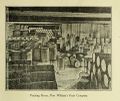Dominion Atlantic Railway Digital Preservation Initiative - Wiki
Use of this site is subject to our Terms & Conditions.
Difference between revisions of "Port Williams Fruit Company"
Dan conlin (talk | contribs) (Created page with "==Port Williams Fruit Company Limited, Port Williams== Mile 51.5 on the Halifax Subdivision ===History=== Built circa 1900 by Henry Welt...") |
Dan conlin (talk | contribs) (→Gallery: image) |
||
| Line 10: | Line 10: | ||
File:201216143.jpg|[[Port Williams]] showing the [[Port Williams Station]], the [[Port Williams Fruit Company]] and other warehouses as well as the evaporator ruins, August 1931. | File:201216143.jpg|[[Port Williams]] showing the [[Port Williams Station]], the [[Port Williams Fruit Company]] and other warehouses as well as the evaporator ruins, August 1931. | ||
File:PortWilliamsFruit1.jpg|The [[Port Williams Fruit Company]] co-op apple warehouse, 1934. | File:PortWilliamsFruit1.jpg|The [[Port Williams Fruit Company]] co-op apple warehouse, 1934. | ||
| + | File:12140.jpg|[[Port Williams Station]], looking west to the [[Port Williams Fruit Company]] warehouse, summer/early fall 1973 just before the station's demolition. | ||
</gallery> | </gallery> | ||
Revision as of 09:31, 26 December 2019
Port Williams Fruit Company Limited, Port Williams
Mile 51.5 on the Halifax Subdivision
History
Built circa 1900 by Henry Welton as a wooden apple warehouse, it was purchased in 1910 by the Port Williams Fruit Company, a co-operative formed by several farmers in the Port William area who banded together to jointly ship and market their apples and potatoes. The company joined other fruit co-ops to form the United Fruit Company organization in 1912. The warehouse had multiple expansions as the co-op grew and offered more services including fertilizer and gasoline. It was extended to the east in 1922 and to the north in 1924. A dust factory for insecticide spray was also added in 1924 and a coal shed was built in 1926. Part of the warehouse was converted to cold storage in 1932. The company was taken over by Scotian Gold in 1965 and continued as a fruit and vegetable warehouse.[1] It was destroyed by a large fire in the early 2000s.
Gallery
The Port Williams Fruit Company co-op apple warehouse interior, 1913.
Port Williams showing the Port Williams Station, the Port Williams Fruit Company and other warehouses as well as the evaporator ruins, August 1931.
The Port Williams Fruit Company co-op apple warehouse, 1934.
Port Williams Station, looking west to the Port Williams Fruit Company warehouse, summer/early fall 1973 just before the station's demolition.
References and Footnotes
- ↑ Edythe Quinn, A History of Greenwich, The Women's Association of Greenwich United Church (1968) p. 39



